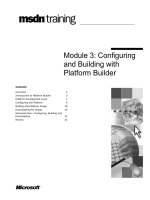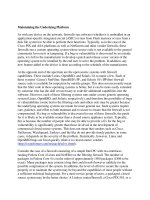Configuring the Platform
Bạn đang xem bản rút gọn của tài liệu. Xem và tải ngay bản đầy đủ của tài liệu tại đây (212.71 KB, 17 trang )
Configuring the Platform
T
his chapter covers
• Understanding scalable architecture
• Logical architecture
• Physical site architecture
• Configuring the Microsoft Content Management Server (MCMS) plat-
form options
• Checking minimum hardware and software requirements
• Installing Windows 2003 Server core components
• Installing Windows XP components
• Installing SQL Server 2000
• Enabling Windows Installer logging
• Creating user accounts
• Initial MCMS administrator
• Initial MCMS account
• Creating the MCMS database and granting rights
• Creating a Web site for MCMS
This chapter describes the various site architectures that support Microsoft
Content Management Server 2002, and why you might choose to configure
them. MCMS installation is covered in Chapter 2. Chapter 3 covers techniques
for performance tuning and capacity planning . Clustering and high-availability
MCMS solutions are not covered in this book.
CHAPTER 1
3
Understanding Scalable Architecture
Some have difficulty seeing the value of MCMS—what it does differently from
a Web server. MCMS turns a Web site into an online document exchange where
content is not only presented, but developed as well. In the introduction, we
discussed some scenarios where this document exchange is vital to a business.
The CMS document exchange paradigm is equally valid for small business or
global enterprise. As noted business analyst Peter Drucker points out, a high
percentage of the American workforce is made up of knowledge workers. A
small business may not have the resources of a mega enterprise; yet its busi-
ness may depend upon empowering knowledge workers to collaborate on
content. MCMS, therefore, supports site architectures geared for each end of
this spectrum and many points in between.
MCMS supports single-server installations. In this configuration, the
entire content management functionality is implemented on one computer.
For many situations this provides adequate throughput and security. At the
opposite end of the spectrum, MCMS provides features to support multitiered,
clustered, server farms with redundant firewalls, domain security, and shared
databases.
MCMS also supports scenarios in which teams of developers work
simultaneously on the same—or independent—MCMS projects. Here devel-
opment machines can be running Windows Server or Windows XP. They can
run SQL Server locally or connect to another machine running SQL Server
remotely.
This chapter examines the platform requirements to support the various
components of MCMS installations. We’ll also cover the various configuration
options identified in the preceding paragraphs.
Logical Architecture
We’ll begin looking at the logical architecture of the MCMS system. Each
component is described later in this section; however, let’s start with a broad
picture.
First, a computer that will be configured to run MCMS must also be
running a version of Windows: Windows Server 2003 (in this chapter, we’ll
be referring to Windows 2003 unless otherwise stated), Windows Server 2000
(only covered peripherally), or Windows XP. Specific details about configur-
ing the Windows operating system are outside the scope of this book, except
where noted. Note that SQL Server must either be present locally or available
remotely.
To the left side of Figure 1-1, you’ll note development components:
Visual Studio, custom Web Services, and the ASPX templates. Visual Studio
has tools for managing the development of MCMS solutions, including cre-
ating the templates. (Creating templates is covered in Chapter 9.)
CHAPTER 1
■
CONFIGURING THE PLATFORM4
Components for accessing content are shown in the top center of the figure.
These components are used by authors and viewers—viewers, in the MCMS
vernacular are called subscribers. This is managed via the HTTP transaction
processor of the Internet Information Server (IIS) Web Service and a custom
MCMS ISAPI filter (covered in Chapter 9).
Figure 1-1. MCMS components
The components of the logical architecture are defined in the follow-
ing list:
• ASPX template file: Placeholders, controls, and so on.
• Authoring Connector: Enables authors to create content and send con-
tent directly to MCMS for publication using Microsoft Office.
• Content Repository: Microsoft SQL Server database (table definitions,
stored procedures); stores information about site structure and content,
including resources.
• Content server: The core MCMS engine.
• Custom Web Service: An MCMS extension to allow a Web application to
interact with MCMS.
CHAPTER 1
■
CONFIGURING THE PLATFORM 5
• ISAPI filter and security service: Serves HTTP requests for the MCMS
Web site, handles authentication of these requests, creates the context
in which ASPX template files run, and assembles the page.
• Placeholder control: Provides data access to the Content Repository
and resources.
• Publishing API: Provides programmatic access to the MCMS object
model used by placeholder control(s) to access and negotiate authoring
mode.
• Visual Studio .NET: Main development environment supports the
various extensions that exploit MCMS features and objects.
• Web author: The main authoring application for MCMS 2002.
Physical Site Architecture
Figure 1-2 shows a typical MCMS site installation. A high-volume production
environment is implemented across an indeterminately large bank of servers—
from a single server handling everything to an entire clustered server farm.
The production environment may or may not be protected behind an exter-
nal firewall. The production environment is supported by a development/
content-authoring environment, which should be protected behind its own
firewall. This environment is built up from a single development server, which
is configured first and can replicate the implementation to the other systems.
Following are the servers shown in Figure 1-2:
• Development server: Contains content database and templates; used in
content rendering; relatively few authorized users access this server.
• Content authoring server: Used by contributors to submit content;
authors, editors, approvers, and administrators access this server to
manage content development.
• Staging server: Provides a platform where content is tested before it is
deployed to the production environment; access to this server is similar
to the content authoring server.
• Production server(s): Provides the live site where users access content.
■
Note
A third deployment option, which is outside the scope of this book, is using the
Site Deployment API in conjunction with Microsoft Application Center 2000 to perform
incremental deployments. This is for non-MCMS sites (ASP.NET-based sites). Refer to
COM-Based Site Deployment in the MCMS product documentation for more information.
For additional information about Application Center 2000, go to
http://go.
microsoft.com/fwlink/?LinkId=9514
.
CHAPTER 1
■
CONFIGURING THE PLATFORM6
Figure 1-2 also implies how workflow progresses. MCMS is deployed to
the development server, providing initial administration and the ability to cre-
ate the site structure, including the content database and templates. The site
is replicated to the authoring server so contributors can post their content
(depending upon the total expected volume, the authoring and development
servers may coexist on a single computer). Many authors generally update
this MCMS frequently. Security and authentication can be time consuming
in the initial stages because individuals and groups of collaborators may be
restricted to certain parts of the site.
The next step—and again, this can all be configured on a single com-
puter—is to implement the staging server that will support the production
environment. Initially, and periodically thereafter, an administrator repli-
cates content from the authoring server to the staging server—usually at
CHAPTER 1
■
CONFIGURING THE PLATFORM 7
Figure 1-2. A typical MCMS installation
scheduled intervals. At this point, the production site can be tested and
prepared for general access. Typically production servers provide dynamic
access to content; however, some servers may need to serve static HTML
pages. The site staging server, therefore, may need to convert dynamic
content to static HTML for some servers.
Finally the production environment is implemented. The complexity
of this chore can vary vastly, depending upon the complexity of the business
solution. If a production environment encompasses relatively few (single)
servers and is tolerant of downtime, manual updating is adequate. On the
other hand, if the production environment needs to be highly available and
not at all tolerant of downtime, this may require failover clustering and redun-
dancy. Traffic may be high enough that load balancing is required. In the
production environment, servers may work in concert, with certain servers
deploying the Content Repository (SQL Server database) for general access.
Some production environments provide anonymous public access to some
shared content and privileged access to other content. Some environments
require a high degree of personalization.
■
Note
Follow the installation steps in this section to install platform software if you do
not have a previous version of MCMS on your computer. If you have MCMS 2001 installed
on your computer, you must follow a different set of steps to upgrade to MCMS 2002. For
information about upgrading to MCMS 2002 from MCMS 2001, see the upgrading instruc-
tions at
/>.
The steps to install the platform software must be completed in the order
presented in this chapter. Before you install MCMS 2002, check to see if you
have already installed the required software.
To install MCMS 2002, you must be a member of the Windows NT
administrators group.
Configuring MCMS Platform Options
This chapter is a quick reference and does not cover all details of the installa-
tion. It does not cover versions of Windows Server other than 2003, though
MCMS 2002 can be configured to interoperate with some other versions. We’ll
also cover configuring Windows XP to support MCMS 2002, which is useful for
development machines.
MCMS 2002 SP1a is compatible with and can be installed on Windows
Server 2003 and Windows XP.
CHAPTER 1
■
CONFIGURING THE PLATFORM8









